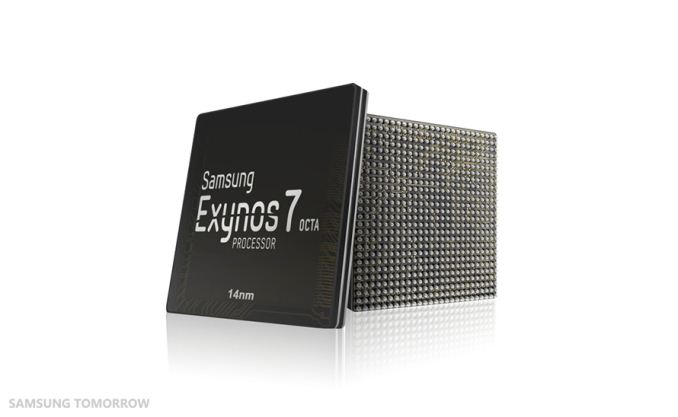Samsung Announces 14nm FinFET for Exynos 7
by Joshua Ho on February 16, 2015 4:04 AM EST- Posted in
- Smartphones
- Mobile
- Tablets
- SoCs

While we've known about the existence of the Exynos 7420 for a while now, we didn't really know what to expect until recently. Today, it seems that Samsung is ready to start disclosing at least a few details about an upcoming Exynos 7 SoC, which is likely to be the Exynos 7420.
At a high level Exynos 7 will have four Cortex A57s clocked at 2.1 GHz, in addition to four Cortex A53s along with an LPDDR4-capable memory interface. According to Samsung Tomorrow, we can expect a 20% increase to device performance, which is likely a reference to clock speed, and 35% lower power consumption. In addition, there is a reference to a 30% productivity gain, which is likely to be referencing performance per watt. Samsung claims that these figures come from a comparison to their 20nm HKMG process, which we've examined before with the Exynos 5433 in the Note 4 Exynos review.
Although there is no direct statement of which version of 14nm is used for this upcoming Exynos 7 Octa, judging by how this is the first 14nm IC to come from Samsung it's likely that this SoC will use 14LPE, which focuses on reducing leakage and power consumption rather than switching speed.
Source: Samsung Tomorrow










111 Comments
View All Comments
essai - Monday, February 16, 2015 - link
And intel doesn't have any process advantage anymore!psyq321 - Monday, February 16, 2015 - link
While different manufacturers have different measurements of nodes, so comparisons are not really "apples to apples", Intel has 14nm parts in commercial production for some time already, so they still can be said to have some advantage, albeit smaller than before.essai - Monday, February 16, 2015 - link
While intel has more experience with FinFETs and probably has a more opimised process, the days of them being at leat one year ahead of the rest are gone. In europe broadwell parts are still hard to come by, while samsung will probably have the S6 shipping everywhere by june, this really reduces intels advantage to just 1quarter, which is pretty negligible. And am not even talking about their atom processors which are still on 22nm. I dont see how they will be able to gain a footing in the mobile market after loosing their process advantage...smilingcrow - Monday, February 16, 2015 - link
I think you have missed the point that you were replying to. Intel's 14nm process is a full shrink so has ALL the gains of a true 14nm process. Whereas the 14 and 16 mm processes of other foundries appear to not be full shrinks so they lack some of the benefits such as comparable size so will be significantly more expensive per square mm.mali_07 - Monday, February 16, 2015 - link
What if told you all these are marketing. Even Intel's 14nm cmos real gate length is more than 20nm!!!! Don't ask me how or else i will be thrown out of my job.smilingcrow - Monday, February 16, 2015 - link
No proof makes you a random person on the web with zero credibility so don't waste your time.LordanSS - Monday, February 16, 2015 - link
Here, since you asked for some proof. What he's saying actually has substance.https://www.semiwiki.com/forum/content/3884-who-wi...
Guest8 - Monday, February 16, 2015 - link
@LordanSS Yeah Semiwiki is a shill for the fabless coundries and is paid for TSMC so there's that. Intel is the only company with a full shrink APU all others are half shrinks that's why their costs are going up while Intels is going down.levizx - Saturday, April 18, 2015 - link
Where's your "proof" now? Exynos 7420 is physically much smaller than 5433 which has less GPU cores.extide - Tuesday, February 17, 2015 - link
It's pretty well known that the xxnm process nodes are just marketing names these days, and the numbers come from a relative shrink ratio. They havent been actual measurements for a long time! This isnt news!!